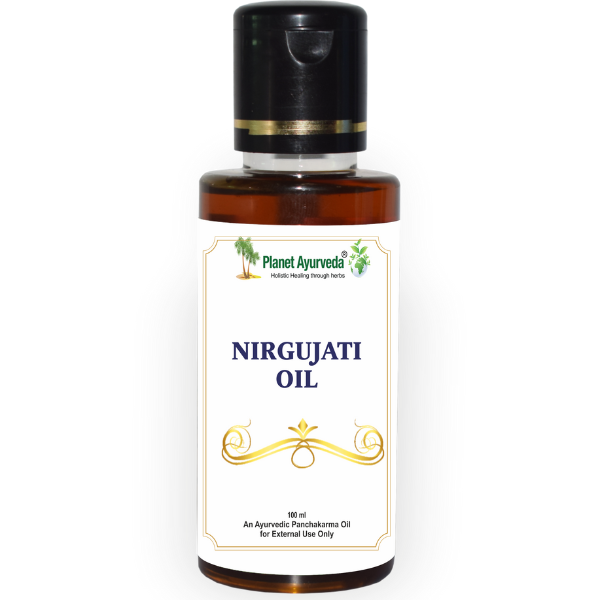Nirgujati Oil – Key Ingredients, Their Benefits, Indications & Panchakarma Uses
Introduction
Nirgujati Oil is a classical Ayurvedic herbal oil formulation offered by Planet Ayurveda, meticulously designed to support joint, muscular, and skeletal health. This time-tested preparation is derived from a careful blend of potent herbs infused in a base of pure sesame oil, following authentic Ayurvedic principles. In Ayurveda, oils infused with medicinal herbs, known as Tailas, are highly valued for their ability to penetrate deep into tissues, nourish Dhatus (body tissues), pacify aggravated Doshas, and restore natural movement. The use of such oils forms an integral part of daily self-care as well as structured Panchakarma therapies, ensuring overall musculoskeletal well-being. Joint disorders such as arthritis (Sandhigata Vata), stiffness, inflammation, and muscular pains are often linked to an imbalance of Vata dosha, which governs movement, circulation, and neuromuscular coordination. Nirgujati Oil works primarily by pacifying aggravated Vata, reducing stiffness, alleviating pain, and strengthening muscles and bones. It is equally beneficial when used in therapeutic massage, Panchakarma therapies, or routine maintenance for preserving joint flexibility and musculoskeletal health. By combining the healing properties of selected herbs with the deep-penetrating qualities of sesame oil, Nirgujati Oil offers a natural, safe, and effective alternative to chemical-based ointments, helping individuals regain mobility and improve the overall quality of life.
Ingredients
Nirgujati Oil is prepared using a blend of carefully chosen herbs, each infused in sesame oil, which acts as a carrier and penetrative medium. The synergy of these herbs ensures pain relief, reduction of inflammation, and improved musculoskeletal functioning.
1. Jati (Jasminum officinale)
Chamelipatra contains essential oils rich in compounds such as benzyl acetate, linalool, indole, and methyl jasmonate, which exhibit potent anti-inflammatory, analgesic, and antispasmodic effects. These phytoconstituents act on the peripheral nerves and muscular tissues, reducing local inflammation and muscle rigidity. The soothing aroma and oil extract of jasmine enhance blood circulation to affected areas, improving tissue oxygenation and promoting cellular repair.
2. Nimba Patra (Azadirachta indica)
Nimba leaves are rich in azadirachtin, nimbin, nimbidin, and quercetin, which possess strong anti-inflammatory, anti-arthritic, and antioxidant properties. These active compounds inhibit prostaglandin and leukotriene synthesis, thereby controlling inflammation and pain in chronic arthritic conditions. Neem’s detoxifying (Rakta shodhak) and anti-microbial effects also help in purifying blood and reducing Ama (metabolic toxins) — the root cause of joint swelling and stiffness in Amavata (RA). By pacifying aggravated Pitta and Vata dosha, it supports healthy joint function and skin health around the inflamed regions.
3. Patol Patra (Trichosanthes dioica)
Patol Patra contains trichosanthin, cucurbitacin, and flavonoids, which exhibit antioxidant and detoxifying properties. These compounds neutralize free radicals, reducing oxidative stress within joint and muscle tissues. In conditions of chronic inflammation such as gout and arthritis, cucurbitacins suppress inflammatory mediators, while trichosanthin promotes liver detoxification — preventing accumulation of toxins that aggravate Vata and Kapha. It thus complements the systemic purification process and enhances the bioavailability of other herbal actives in the oil.
4. Karanj Patra (Pongamia pinnata)
Karanj leaves contain karanjin, pongamol, and flavonoids, known for their anti-inflammatory, anti-microbial, and analgesic properties. Karanjin acts by inhibiting nitric oxide production and pro-inflammatory cytokines, thereby reducing joint inflammation and muscle pain. Its deep tissue penetration enhances local blood flow and helps dissolve Ama accumulations in the joints. The Tikta-Katu rasa (bitter-pungent taste) and Ushna virya (hot potency) of Karanj Patra help pacify Vata and Kapha doshas, making it highly effective in Vatarakta (gout) and chronic musculoskeletal stiffness.
5. Siktha (Bee Wax)
Bee wax, rich in esters of fatty acids and long-chain alcohols, acts as a natural emollient and stabilizer. It facilitates even distribution of herbal extracts, enhances absorption through the skin, and provides a protective layer that retains warmth and moisture in affected areas. Its mild anti-inflammatory and soothing effects reduce irritation while improving the oil’s texture for therapeutic massage. Bee wax thus serves both a functional and pharmacological purpose — aiding joint lubrication and easing muscular stiffness.
6. Haridra (Curcuma longa)
Haridra’s principal bioactive compound curcumin is renowned for its potent anti-inflammatory, antioxidant, and chondroprotective properties. Curcumin inhibits NF-κB activation and downregulates inflammatory cytokines such as TNF-α and IL-6, effectively reducing pain and swelling in arthritic joints. It also enhances microcirculation and prevents cartilage degeneration, making it vital in managing Vatarakta (Gout) and Sandhigata Vata (Osteoarthritis). The Katu-Tikta rasa (pungent-bitter taste) and Ushna virya (hot potency) further help in dissolving Ama (Endotoxins) and pacifying Vata-Kapha doshas.
7. Yashti (Glycyrrhiza glabra)
Yashti or Licorice contains glycyrrhizin, liquiritin, and glabridin, which demonstrate strong anti-inflammatory and immunomodulatory actions. Glycyrrhizin acts similarly to corticosteroids but without adverse effects, thereby reducing swelling and joint inflammation. Its antioxidant properties help regenerate tissues and soothe irritated nerves. Licorice also supports adrenal function and enhances the body’s resilience against chronic inflammatory stress, making it an excellent supporting agent in degenerative joint disorders and Vata-predominant diseases.
8. Daruharidra (Berberis aristata)
The active alkaloid berberine in Daruharidra is a powerful anti-inflammatory and antimicrobial compound. It reduces oxidative damage to synovial membranes and inhibits prostaglandin synthesis, thereby alleviating pain and swelling. Additionally, berberine improves microcirculation and promotes wound healing in inflammatory conditions. Its Tikta rasa (bitter taste) and Ushna virya (hot potency) help detoxify the blood and clear blocked Srotas (microchannels), which are crucial in joint nourishment and flexibility restoration.
9. Manjisthha (Rubia cordifolia)
Manjisthha contains rubiadin, purpurin, and alizarin, which exhibit potent blood-purifying, anti-inflammatory, and antioxidant properties. These phytoconstituents promote lymphatic drainage and help eliminate metabolic toxins responsible for inflammatory joint disorders. Manjisthha also reduces stiffness and edema by improving circulation and balancing Rakta (blood) and Pitta doshas. Its deep-cleansing action enhances tissue oxygenation and complements other herbs in promoting joint rejuvenation and pain relief.
10. Padmakh (Prunus cerasoides)
Padmakh contains flavonoids, tannins, and phenolic acids, which possess antioxidant and anti-inflammatory properties. These compounds protect connective tissues from free radical damage and help maintain elasticity in joint cartilage. The astringent and cooling nature of Padmakh supports detoxification and soothes inflamed tissues, reducing burning sensations and stiffness. It thus strengthens musculoskeletal integrity and supports repair processes.
11. Lodhra (Symplocos racemosa)
Lodhra’s bioactive compounds — symplocoside, colloturine, and loturine — exhibit astringent, anti-inflammatory, and antioxidant actions. These phytochemicals stabilize capillary membranes, reduce inflammatory edema, and prevent degeneration of joint tissues. Lodhra’s Kashaya rasa (astringent taste) and Sheeta virya (cool potency) help pacify Pitta while toning local tissues, making it particularly useful in inflamed and swollen joints associated with Vatarakta and Sandhigata Vata.
12. Haritaki (Terminalia chebula)
Haritaki contains chebulinic acid, chebulagic acid, and tannins, which possess strong antioxidant, anti-inflammatory, and rejuvenative properties. These compounds scavenge free radicals, protect synovial membranes, and reduce stiffness. Haritaki’s ability to enhance metabolism and eliminate Ama helps in clearing blockages from Srotas, ensuring proper nutrient delivery to joint tissues. Its Tridoshahara nature makes it a foundational ingredient in managing systemic causes of joint pain and inflammation.
13. Neelophar (Nymphea stellata)
Neelophar or Blue Lotus is enriched with nupharine, nymphaline, and flavonoids, which possess cooling, anti-inflammatory, and analgesic properties. These bioactives calm aggravated Pitta and Vata doshas, reduce muscle tension, and soothe nerve irritation. Neelophar enhances relaxation during topical application, aiding in muscular and joint pain relief while improving local circulation and cellular repair.
14. Sariva (Hemidesmus indicus)
Sariva contains hemidesmin, saponins, and coumarins, which possess blood-purifying, anti-inflammatory, and antipyretic effects. These constituents alleviate inflammatory responses in chronic arthritic conditions. Sariva’s Sheeta virya (cool potency) provides soothing relief in burning and inflamed joints, while its rejuvenative properties promote the regeneration of connective tissues, maintaining elasticity and smooth joint movement.
15. Chakramard (Cassia tora)
Chakramard is rich in chrysophanol, emodin, and anthraquinones, which exhibit anti-inflammatory and analgesic effects by modulating inflammatory mediators like COX and LOX enzymes. It helps reduce swelling and muscular cramps, while its detoxifying properties prevent recurrence of inflammatory episodes. The herb’s Katu-Tikta rasa (pungent-bitter taste) aids in Ama pachana (digesting metabolic toxins), crucial for restoring normal joint physiology.
16. Karanj Beej (Pongamia pinnata)
Karanj Beej shares similar active constituents with Karanj Patra, primarily karanjin and pongamol, but in higher concentration, enhancing its potency. These bioactives reduce pro-inflammatory cytokines and oxidative stress in joint tissues. Karanj Beej oil improves synovial lubrication, eases stiffness, and acts as a natural counterirritant. It provides warmth and deep penetration, pacifying Vata and supporting muscle relaxation.
17. Nirgundi (Vitex negundo)
Nirgundi contains flavonoids (vitexin, negundoside), iridoid glycosides, and casticin, which exhibit strong anti-inflammatory, analgesic, and antioxidant effects. These compounds suppress COX-2 and IL-6 activity, reducing pain and swelling. Nirgundi enhances local blood circulation, helps remove Ama, and supports nerve relaxation, making it the primary herb in Nirgujati Oil for conditions like Sandhigata Vata (Osteoarthritis), Vatarakta (Gout), and Greeva Stambha (neck stiffness). It acts as a natural muscle relaxant and pain reliever for chronic musculoskeletal disorders.
18. Sesame Oil (Sesamum indicum) – Base Oil
Sesame oil, or Til Taila, is regarded as one of the best oils in Ayurveda for Vata-related disorders. Rich in antioxidants, vitamins, and natural lubricants, it forms the perfect base for Nirgujati Oil. Its penetrating quality (Sookshma Guna) allows herbal extracts to be absorbed deeply into the tissues, nourishing muscles, ligaments, and bones while providing long-lasting relief. Sesame oil also supports joint lubrication and promotes elasticity of connective tissues, which is particularly important for preventing stiffness and maintaining healthy movement. This combination of Nirgundi, Jati, and sesame oil creates a synergistic effect, making Nirgujati Oil a comprehensive and holistic choice for managing musculoskeletal health, pain, and stiffness.
Benefits of Nirgujati Oil
Nirgujati Oil offers a multitude of therapeutic benefits for bones, muscles, and joints. Unlike conventional pain-relief products that offer temporary symptomatic relief, Nirgujati Oil works on the root cause of musculoskeletal imbalance, particularly aggravated Vata dosha.
- Provides quick relief from joint pain, swelling, and stiffness. Regular application helps restore natural joint movement and improves flexibility.
- Reduces inflammation associated with arthritis, gout, and other musculoskeletal disorders.
- Supports mobility and flexibility of joints, making it beneficial for elderly individuals with age-related stiffness.
- Strengthens muscles, ligaments, and bones by nourishing deeper tissues through topical absorption.
- Improves blood and lymph circulation when used in massage, which aids in faster healing of injured or overstrained areas.
- Reduces stiffness in conditions such as frozen shoulder, backache, and cervical pain, allowing for smoother joint movement.
- Enhances recovery from sprains, strains, and sports injuries due to its anti-inflammatory and analgesic properties.
- Pacifies aggravated Vata Dosha, which is considered the primary cause of joint degeneration and chronic musculoskeletal pain in Ayurveda.
- Acts as a natural analgesic, avoiding the side effects often associated with chemical-based pain relief balms or ointments.
- Promotes relaxation and well-being, improving the overall quality of life for individuals suffering from chronic joint and muscular conditions.
By integrating Nirgujati Oil into regular care, individuals can experience long-term benefits, including reduced recurrence of stiffness and pain, increased joint strength, and improved day-to-day mobility.
Ideal for (Indications)
Nirgujati Oil is highly recommended in a wide range of musculoskeletal and joint-related conditions
- Arthritis (Sandhigata Vata) – Reduces pain, swelling, and joint stiffness.
- Gout (Vatarakta) – Assists in reducing uric acid-related joint inflammation.
- Cervical spondylitis and lumbar spondylitis – Provides relief from neck and lower back stiffness.
- Frozen shoulder – Improves joint flexibility and reduces pain.
- Backache and neck stiffness – Supports deeper tissue healing.
- Muscular pain and cramps – Relaxes tense muscles.
- Sprains, strains, and minor injuries – Accelerates recovery and reduces inflammation.
- Osteoarthritis and age-related joint stiffness – Enhances joint mobility and lubrication.
- Post-traumatic musculoskeletal pain – Aids in rehabilitation and tissue strengthening.
Panchakarma Use
In Panchakarma therapies, herbal oils play a central role in balancing Doshas, nourishing Dhatus, and eliminating toxins (Ama). Nirgujati Oil can be effectively used in multiple Panchakarma procedures
- Abhyanga (Therapeutic Massage) – Regular massage with Nirgujati Oil relieves Vata aggravation, nourishes muscles, lubricates joints, and improves circulation, promoting overall musculoskeletal health.
- Svedana (Sudation Therapy) – When combined with steam therapy, it enhances absorption of herbal actives, reduces stiffness, and promotes flexibility in affected joints and muscles.
- Kati Basti (Oil Pooling over Lower Back) – Particularly useful in chronic back pain, sciatica, and lumbar stiffness, providing deep tissue nourishment.
- Greeva Basti (Oil Pooling over Neck) – Effective in cervical spondylitis, neck stiffness, and tension-related pain, allowing for relaxation of tight muscles.
- Patra Pinda Sweda (Herbal Leaf Fomentation) – Enhances the effect of Nirgujati Oil, especially in painful joints and localized inflammation.
Use of Nirgujati Oil in Panchakarma not only detoxifies the body but also strengthens musculoskeletal tissues, reduces recurrence of pain, and provides long-lasting relief from chronic joint and muscle discomfort.
To buy Nirgujati Oil, please visit store.planetayurveda.com/products/nirgujati-oil
Conclusion
Nirgujati Oil by Planet Ayurveda is a time-tested, holistic formulation that integrates the healing power of Nirgundi, Jati, and sesame oil. Its natural anti-inflammatory, analgesic, and Vata-balancing properties make it an excellent solution for joint stiffness, pain, and musculoskeletal disorders. Whether incorporated in daily massage routines, applied during therapeutic Panchakarma procedures, or used for specific conditions like arthritis, cervical spondylitis, and frozen shoulder, Nirgujati Oil promotes long-term joint health, mobility, and flexibility. Its natural formulation ensures safe use without harmful side effects, unlike chemical pain relief creams or ointments. By including Nirgujati Oil in regular self-care or clinical treatments, individuals can experience natural pain relief, enhanced joint movement, stronger muscles, and an overall improvement in quality of life. Authentic Ayurvedic care, as demonstrated through Nirgujati Oil, emphasizes balancing Doshas, nourishing Dhatus, and restoring harmony within the body, leading to sustainable musculoskeletal wellness.




